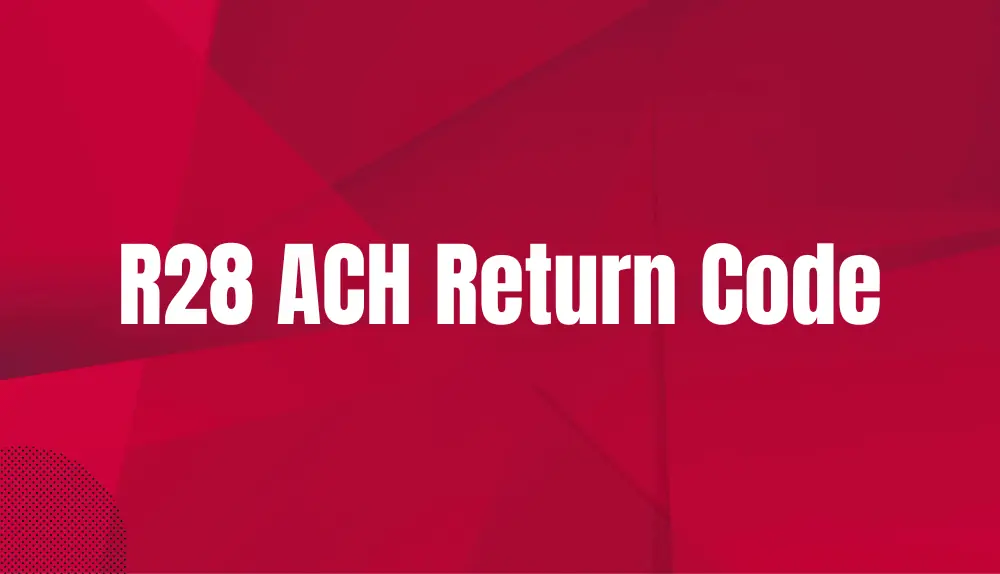R28 is an integral system of ACH and this article will explain the details about R28 ACH return code, also known as code for routing number check digit error.
What Does R28 ACH Return Code Mean?
The ACH R28 Return Code signifies a Routing Number Check Digit Error in the Automated Clearing House (ACH) system. In the world of electronic transactions, precision is paramount, and the R28 code is invoked when a routing number’s check digit does not match the expected value. The routing number, a crucial element in ACH transactions, is a nine-digit code used to identify financial institutions. It contains a check digit, calculated based on a specific algorithm, to help ensure data accuracy and prevent errors during transfers.
When a receiving bank detects a mismatch between the transmitted check digit and the calculated one, it triggers the R28 Return Code. This indicates that the payment could not be processed due to a potential data entry error or other issues in the routing number. Such errors can lead to delays or rejections of transactions, highlighting the importance of double-checking routing information before initiating ACH transfers. Resolving the R28 error promptly is essential to maintain the smooth flow of electronic payments and avoid disruptions in the interconnected world of financial transactions.
Reasons ACH R28 Return Code Can Occur

Automated Clearing House (ACH) transactions are a critical component of modern banking, enabling seamless electronic fund transfers. However, the smooth flow of ACH transactions can sometimes be disrupted by the occurrence of the ACH R28 Return Code – Routing Number Check Digit Error. Several reasons can lead to this error, each demanding attention and resolution to maintain the integrity of the ACH system.
Data Entry Errors
One of the most common reasons for the ACH R28 Return Code is simple human error. During the initiation of an ACH transaction, if the sender incorrectly inputs the routing number or fails to transcribe it accurately, the receiving bank’s system will identify a mismatch in the check digit during the verification process. Even a single mistyped digit can trigger the R28 code and result in the rejection of the transaction.
Outdated or Incorrect Routing Information
Financial institutions undergo changes such as mergers, acquisitions, or the opening of new branches, which may lead to changes in their routing numbers. If a sender uses outdated or incorrect routing information for a specific financial institution, the receiving bank will detect a check digit discrepancy, resulting in the ACH R28 Return Code.
Incorrectly Formatted Files
ACH transactions require strict adherence to specific file formats for successful processing. If the file containing the ACH batch is improperly formatted or contains data in the wrong order, it can cause errors during the routing number validation process, leading to the R28 Return Code.
Fraud Prevention Measures
Financial institutions implement stringent fraud prevention measures, and one of them involves validating routing numbers using their check digits. If a sender’s ACH transaction appears suspicious or raises red flags in the system, it may trigger the R28 code as a precautionary measure to prevent potential fraudulent activities.
Technical Glitches
In rare instances, technical issues within the ACH processing system can cause the R28 Return Code to occur erroneously. System updates, software glitches, or network interruptions may disrupt the routing number validation process and lead to the generation of false check digit errors.
To mitigate the occurrence of the ACH R28 Return Code, it is essential for financial institutions and ACH users to double-check and validate routing information before initiating transactions. Implementing robust data validation procedures, regularly updating routing databases, and ensuring adherence to proper file formats can significantly reduce the likelihood of encountering this error, thereby promoting the seamless flow of electronic fund transfers through the ACH system.
Steps to Fix ACH R28 Return Code

Fixing the ACH R28 Return Code requires prompt attention and accurate resolution to ensure successful electronic fund transfers. Below are the essential steps to address and rectify the R28 error:
Verify Routing Information
Double-check the routing number and the associated account details provided by the sender. Ensure the routing number is accurate and up-to-date to avoid any discrepancies during the validation process.
Cross-Check the File Format
If you are the originator of the ACH transaction, review the ACH batch file format to ensure it adheres to the specific requirements outlined by the ACH network. Correct any formatting issues, such as data order or spacing errors that may be triggering the R28 Return Code.
Contact the Receiving Bank
If you are the sender, reach out to the receiving bank to confirm the reason for the R28 error. They may provide more specific information about the check digit mismatch or any other issues causing the rejection.
Rectify Data Entry Errors
In cases of data entry errors, correct the inaccuracies and reinitiate the ACH transaction with the accurate routing number and account information. Pay close attention to all digits, as even a single incorrect digit can trigger the R28 Return Code.
Update Routing Information (If Applicable)
If the R28 error is due to outdated routing information, update the records with the correct routing number for the intended financial institution. Verify the routing number with the receiving bank or use reliable routing number lookup tools.
Review Fraud Prevention Measures
For financial institutions, carefully review any R28 errors triggered by fraud prevention measures. Ensure that genuine transactions are not being falsely flagged and rejected. Fine-tune the fraud detection algorithms to minimize false positives.
Test Transactions (For Technical Glitches)
In case of suspected technical glitches, perform test transactions to identify the root cause. Monitor the ACH processing system for any abnormalities and involve technical support if necessary to resolve the issue.
Monitor Future Transactions
After applying the necessary fixes, closely monitor subsequent ACH transactions to ensure they are processed smoothly without encountering the R28 Return Code. Vigilance in maintaining accurate data and adhering to ACH guidelines is crucial to prevent future errors.
Seek Professional Guidance (If Needed)
If you encounter persistent issues with the ACH R28 Return Code despite efforts to resolve them, consider seeking assistance from ACH experts or contacting your financial institution’s support team for further guidance.
By following these steps and staying diligent in the ACH transaction process, you can rectify the ACH R28 Return Code and facilitate seamless electronic fund transfers in the future.
How Can Businesses Deal with ACH R28 Return Code

Dealing with the ACH R28 Return Code can be a challenging but manageable task for businesses. Handling the R28 error promptly and effectively is crucial to maintaining smooth financial operations. Here are some steps and best practices that businesses can follow to effectively deal with the ACH R28 Return Code:
Identify the Reason for the R28 Return Code
When a business receives an ACH R28 Return Code, the first step is to identify the reason for the rejection. This may involve contacting the receiving bank or the ACH processor for specific details about the check digit error. Understanding the root cause is essential to implement the right solution.
Review and Validate Routing Information
Businesses must thoroughly review and validate the routing information provided by their customers or vendors before initiating ACH transactions. Using reliable routing number lookup tools and cross-referencing the information with the receiving bank’s records can help ensure accuracy.
Address Data Entry Errors
If data entry errors are identified as the cause of the R28 error, businesses should rectify the inaccuracies and reinitiate the ACH transaction with the corrected routing information.
Update Routing Information (If Necessary)
In cases where outdated routing information is causing the R28 error, businesses must update their records with the correct routing numbers of the receiving financial institutions.
Implement Robust Data Validation Procedures
To minimize the occurrence of the ACH R28 Return Code, businesses should implement robust data validation procedures. This includes verifying account and routing numbers against established formats and check digit algorithms.
Monitor Transactions and Fraud Prevention Measures
Businesses should closely monitor ACH transactions for any patterns that trigger the R28 code. They should also ensure that their fraud prevention measures are not overly aggressive, leading to genuine transactions being rejected erroneously.
Establish Communication Channels
Maintaining open communication channels with customers, vendors, and financial institutions is essential. If an ACH transaction is rejected due to the R28 error, promptly notify the affected parties and work together to resolve the issue.
Seek Professional Assistance (If Needed)
For businesses experiencing persistent issues with the ACH R28 Return Code, seeking professional guidance from experts in ACH processing and compliance can be beneficial. These experts can provide insights and best practices to improve ACH transaction success rates.
Continuous Training and Education
Regularly train employees involved in ACH transactions to stay updated on industry regulations, best practices, and potential pitfalls that may lead to the R28 error. Knowledgeable staff can help reduce errors and enhance transaction accuracy.
Implement Contingency Plans
Having contingency plans in place for ACH transaction rejections can minimize disruptions to business operations. This may include alternative payment methods or backup accounts to use in case of ACH processing issues.
By following these steps and incorporating best practices into their ACH processing procedures, businesses can effectively manage and reduce the occurrence of the ACH R28 Return Code, ensuring smoother and more efficient electronic fund transfers.
Final Words
The ACH R28 Return Code, symbolizing a Routing Number Check Digit Error, underscores the critical importance of accuracy and attention to detail in the world of electronic fund transfers. Businesses and financial institutions must be vigilant in their ACH processing procedures, diligently verifying routing information and implementing robust data validation measures.
Promptly addressing the root causes of the R28 error, such as data entry mistakes or outdated routing information, can help maintain the integrity of the ACH system and ensure seamless transactions. Furthermore, constant monitoring, effective communication, and ongoing training are essential components of a successful strategy to deal with the ACH R28 Return Code.
By adopting these best practices and seeking professional guidance when necessary, businesses can navigate the complexities of the ACH system with confidence, fostering trust and efficiency in their financial operations. Embracing these principles will not only minimize disruptions caused by the R28 error but also contribute to a smoother, more secure, and reliable ACH ecosystem, benefiting businesses and customers alike in the dynamic world of electronic banking.
Frequently Asked Questions (FAQs)
How can businesses prevent the ACH R28 Return Code from happening?
Businesses can minimize the occurrence of the ACH R28 Return Code by implementing robust data validation procedures, cross-checking routing information before initiating ACH transactions, updating routing databases regularly, and closely monitoring ACH transaction patterns and fraud prevention measures.
What should I do if I receive an ACH R28 Return Code for a transaction?
If you receive an ACH R28 Return Code for a transaction, first identify the reason for the error by contacting the receiving bank or ACH processor. Once you determine the cause, take appropriate action, such as correcting data entry errors, updating routing information, or addressing technical issues, to resolve the error.
Can the ACH R28 Return Code be reversed?
Yes, the ACH R28 Return Code can be resolved and reversed. By identifying and rectifying the underlying issue that caused the error, businesses can reinitiate the ACH transaction with the correct routing information, leading to successful fund transfers.
Are there any fees associated with the ACH R28 Return Code?
Financial institutions may impose fees for rejected ACH transactions, including those triggered by the ACH R28 Return Code. It is essential for businesses to check their specific agreements and terms with the bank to understand any potential fees.
Can technical issues lead to the ACH R28 Return Code erroneously?
Yes, in rare instances, technical issues within the ACH processing system can cause the ACH R28 Return Code to be generated erroneously. Businesses should closely monitor the system and involve technical support if needed to address such issues promptly.
How long does it take to resolve an ACH R28 Return Code issue?
The time to resolve an ACH R28 Return Code issue varies depending on the cause and the efficiency of the corrective actions taken. In some cases, it can be resolved quickly once the underlying problem is identified and fixed, while in others, it may require additional communication and coordination with involved parties.

